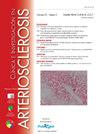Hipertrigliceridemia (> 150 mg/dl) como marcador de riesgo cardiovascular
IF 1.9
Q3 PERIPHERAL VASCULAR DISEASE
引用次数: 0
Abstract
In patients who have achieved optimal LDL-C control, there remains a residual risk of atherothrombotic cardiovascular disease (ASCVD) related to alterations in lipid metabolism, among which alterations in triglyceride-rich lipoproteins and the cholesterol they contain, known as remnant cholesterol, play a major role. Remnant cholesterol is related to ASCVD risk that is independent of LDL-C and has been demonstrated in epidemiological and Mendelian randomization studies. Numerous epidemiological and genetic Mendelian randomization studies support that elevated triglyceride-rich lipoproteins (TRL) and remnant cholesterol are causally associated with ASCVD, myocardial infarction, ischemic stroke, aortic valve stenosis, and all-cause mortality. The remnant particles of triglyceride-rich lipoproteins are highly atherogenic due to their ability to enter and be retained in the arterial wall, their high cholesterol content, and their capacity to generate foam cells, induce endothelial dysfunction, a prothrombotic environment, and a vascular inflammatory response. Assessment of remnant cholesterol can provide information about residual ASCVD risk beyond that provided by LDL-C, non-HDL-C, and apoB, particularly in individuals with hypertriglyceridemia, type 2 diabetes, or metabolic syndrome.
高甘油三酯血症(>150mg/dL)作为心血管风险的标志。
在达到最佳LDL-C控制的患者中,仍然存在与脂质代谢改变相关的动脉粥样硬化血栓性心血管疾病(ASCVD)的残留风险,其中富含甘油三酯的脂蛋白及其所含胆固醇(称为残余胆固醇)的改变起主要作用。残余胆固醇与ASCVD风险相关,与LDL-C无关,并已在流行病学和孟德尔随机化研究中得到证实。大量流行病学和遗传孟德尔随机化研究支持富甘油三酯脂蛋白(TRL)和残余胆固醇升高与ASCVD、心肌梗死、缺血性卒中、主动脉瓣狭窄和全因死亡率有因果关系。富含甘油三酯的脂蛋白的残余颗粒具有高度的致动脉粥样硬化性,因为它们能够进入并保留在动脉壁中,它们的高胆固醇含量,以及它们产生泡沫细胞的能力,诱导内皮功能障碍,血栓形成前环境和血管炎症反应。残余胆固醇的评估可以提供比LDL-C、非hdl - c和载脂蛋白ob提供的更多关于残余ASCVD风险的信息,特别是在高甘油三酯血症、2型糖尿病或代谢综合征患者中。
本文章由计算机程序翻译,如有差异,请以英文原文为准。
求助全文
约1分钟内获得全文
求助全文
来源期刊

Clinica e Investigacion en Arteriosclerosis
PERIPHERAL VASCULAR DISEASE-
CiteScore
3.20
自引率
6.20%
发文量
44
审稿时长
40 days
期刊介绍:
La publicación idónea para acceder tanto a los últimos originales de investigación como a formación médica continuada sobre la arteriosclerosis y su etiología, epidemiología, fisiopatología, diagnóstico y tratamiento. Además, es la publicación oficial de la Sociedad Española de Arteriosclerosis.
 求助内容:
求助内容: 应助结果提醒方式:
应助结果提醒方式:


